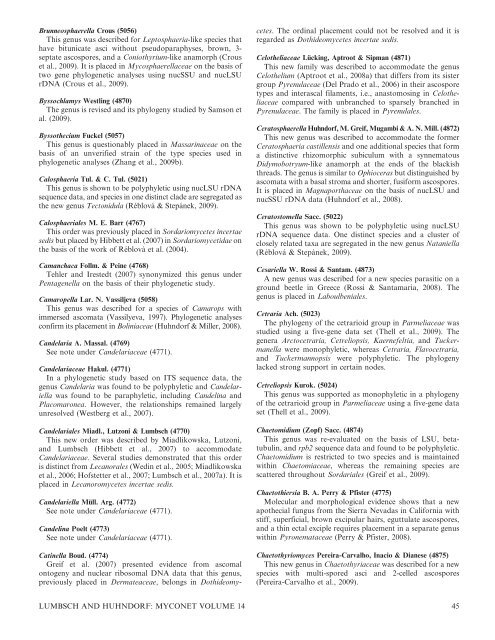Create successful ePaper yourself
Turn your PDF publications into a flip-book with our unique Google optimized e-Paper software.
Brunneosphaerella Crous (5056)<br />
This genus was described for Leptosphaeria-like species that<br />
have bitunicate asci without pseudoparaphyses, brown, 3septate<br />
ascospores, <strong>and</strong> a Coniothyrium-like anamorph (Crous<br />
et al., 2009). It is placed in Mycosphaerellaceae on the basis of<br />
two gene phylogenetic analyses using nucSSU <strong>and</strong> nucLSU<br />
rDNA (Crous et al., 2009).<br />
Byssochlamys Westling (4870)<br />
The genus is revised <strong>and</strong> its phylogeny studied by Samson et<br />
al. (2009).<br />
Byssothecium Fuckel (5057)<br />
This genus is questionably placed in Massarinaceae on the<br />
basis of an unverified strain of the type species used in<br />
phylogenetic analyses (Zhang et al., 2009b).<br />
Calosphaeria Tul. & C. Tul. (5021)<br />
This genus is shown to be polyphyletic using nucLSU rDNA<br />
sequence data, <strong>and</strong> species in one distinct clade are segregated as<br />
the new genus Tectonidula (Réblová & Stepánek, 2009).<br />
Calosphaeriales M. E. Barr (4767)<br />
This order was previously placed in Sordariomycetes incertae<br />
sedis but placed by Hibbett et al. (2007) in Sordariomycetidae on<br />
the basis of the work of Réblová et al. (2004).<br />
Camanchaca Follm. & Peine (4768)<br />
Tehler <strong>and</strong> Irestedt (2007) synonymized this genus under<br />
Pentagenella on the basis of their phylogenetic study.<br />
Camaropella Lar. N. Vassiljeva (5058)<br />
This genus was described for a species of Camarops with<br />
immersed ascomata (Vassilyeva, 1997). Phylogenetic analyses<br />
confirm its placement in Boliniaceae (Huhndorf & Miller, 2008).<br />
C<strong>and</strong>elaria A. Massal. (4769)<br />
See note under C<strong>and</strong>elariaceae (4771).<br />
C<strong>and</strong>elariaceae Hakul. (4771)<br />
In a phylogenetic study based on ITS sequence data, the<br />
genus C<strong>and</strong>elaria was found to be polyphyletic <strong>and</strong> C<strong>and</strong>elariella<br />
was found to be paraphyletic, including C<strong>and</strong>elina <strong>and</strong><br />
Placomaronea. However, the relationships remained largely<br />
unresolved (Westberg et al., 2007).<br />
C<strong>and</strong>elariales Miadl., Lutzoni & Lumbsch (4770)<br />
This new order was described by Miadlikowska, Lutzoni,<br />
<strong>and</strong> Lumbsch (Hibbett et al., 2007) to accommodate<br />
C<strong>and</strong>elariaceae. Several studies demonstrated that this order<br />
is distinct from Lecanorales (Wedin et al., 2005; Miadlikowska<br />
et al., 2006; Hofstetter et al., 2007; Lumbsch et al., 2007a). It is<br />
placed in Lecanoromycetes incertae sedis.<br />
C<strong>and</strong>elariella Müll. Arg. (4772)<br />
See note under C<strong>and</strong>elariaceae (4771).<br />
C<strong>and</strong>elina Poelt (4773)<br />
See note under C<strong>and</strong>elariaceae (4771).<br />
Catinella Boud. (4774)<br />
Greif et al. (2007) presented evidence from ascomal<br />
ontogeny <strong>and</strong> nuclear ribosomal DNA data that this genus,<br />
previously placed in Dermateaceae, belongs in Dothideomy-<br />
cetes. The ordinal placement could not be resolved <strong>and</strong> it is<br />
regarded as Dothideomycetes incertae sedis.<br />
Celotheliaceae Lücking, Aptroot & Sipman (4871)<br />
This new family was described to accommodate the genus<br />
Celothelium (Aptroot et al., 2008a) that differs from its sister<br />
group Pyrenulaceae (Del Prado et al., 2006) in their ascospore<br />
types <strong>and</strong> interascal filaments, i.e., anastomosing in Celotheliaceae<br />
compared with unbranched to sparsely branched in<br />
Pyrenulaceae. The family is placed in Pyrenulales.<br />
Ceratosphaerella Huhndorf, M. Greif, Mugambi & A. N. Mill. (4872)<br />
This new genus was described to accommodate the former<br />
Ceratosphaeria castillensis <strong>and</strong> one additional species that form<br />
a distinctive rhizomorphic subiculum with a synnematous<br />
Didymobotryum-like anamorph at the ends of the blackish<br />
threads. The genus is similar to Ophioceras but distinguished by<br />
ascomata with a basal stroma <strong>and</strong> shorter, fusiform ascospores.<br />
It is placed in Magnaporthaceae on the basis of nucLSU <strong>and</strong><br />
nucSSU rDNA data (Huhndorf et al., 2008).<br />
Ceratostomella Sacc. (5022)<br />
This genus was shown to be polyphyletic using nucLSU<br />
rDNA sequence data. One distinct species <strong>and</strong> a cluster of<br />
closely related taxa are segregated in the new genus Nataniella<br />
(Réblová & Stepánek, 2009).<br />
Cesariella W. Rossi & Santam. (4873)<br />
A new genus was described for a new species parasitic on a<br />
ground beetle in Greece (Rossi & Santamaria, 2008). The<br />
genus is placed in Laboulbeniales.<br />
Cetraria Ach. (5023)<br />
The phylogeny of the cetrarioid group in Parmeliaceae was<br />
studied using a five-gene data set (Thell et al., 2009). The<br />
genera Arctocetraria, Cetreliopsis, Kaernefeltia, <strong>and</strong> Tuckermanella<br />
were monophyletic, whereas Cetraria, Flavocetraria,<br />
<strong>and</strong> Tuckermannopsis were polyphyletic. The phylogeny<br />
lacked strong support in certain nodes.<br />
Cetreliopsis Kurok. (5024)<br />
This genus was supported as monophyletic in a phylogeny<br />
of the cetrarioid group in Parmeliaceae using a five-gene data<br />
set (Thell et al., 2009).<br />
Chaetomidium (Zopf) Sacc. (4874)<br />
This genus was re-evaluated on the basis of LSU, betatubulin,<br />
<strong>and</strong> rpb2 sequence data <strong>and</strong> found to be polyphyletic.<br />
Chaetomidium is restricted to two species <strong>and</strong> is maintained<br />
within Chaetomiaceae, whereas the remaining species are<br />
scattered throughout Sordariales (Greif et al., 2009).<br />
Chaetothiersia B. A. Perry & Pfister (4775)<br />
Molecular <strong>and</strong> morphological evidence shows that a new<br />
apothecial fungus from the Sierra Nevadas in California with<br />
stiff, superficial, brown excipular hairs, eguttulate ascospores,<br />
<strong>and</strong> a thin ectal exciple requires placement in a separate genus<br />
within Pyronemataceae (Perry & Pfister, 2008).<br />
Chaetothyriomyces Pereira-Carvalho, Inacio & Dianese (4875)<br />
This new genus in Chaetothyriaceae was described for a new<br />
species with multi-spored asci <strong>and</strong> 2-celled ascospores<br />
(Pereira-Carvalho et al., 2009).<br />
LUMBSCH AND HUHNDORF: MYCONET VOLUME 14 45

















